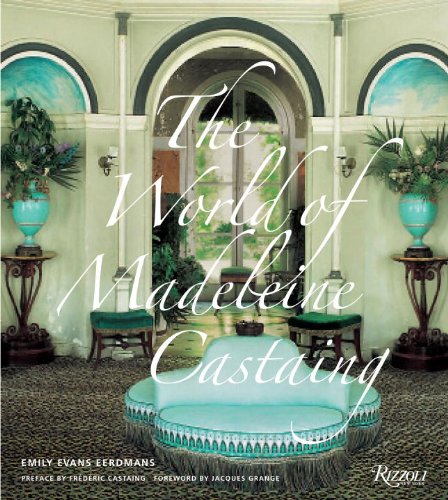 Look carefully - very carefully. This is not a seventeenth century Old Master still-life, but a vignette meticulously and exquisitely conceived, realized and photographed by Paulette Tavormina.
Look carefully - very carefully. This is not a seventeenth century Old Master still-life, but a vignette meticulously and exquisitely conceived, realized and photographed by Paulette Tavormina. I had the pleasure of sitting down with Paulette - who is as glamorous (think Rita Hayworth) as she is talented - and heard the fascinating story of how all her diverse interests and experiences have beautifully coalesced into her stunning "Natura Morta" series.
I had the pleasure of sitting down with Paulette - who is as glamorous (think Rita Hayworth) as she is talented - and heard the fascinating story of how all her diverse interests and experiences have beautifully coalesced into her stunning "Natura Morta" series.With an early love of art history and an appreciation for objects (I think you are either a person who connects to "things" and imbues them with emotion and memory - or you're not), Paulette began her career in commercial photography and soon specialized in styling and shooting food for cookbooks. This led to creating food scenes and props for films. (That steak Anthony Hopkins ate in Nixon with bloody juice seeping out is Paulette's handiwork). To complete the circle of photography to food to art, Paulette has spent the past few years capturing the most rare masterpieces in the world with her lens for Sotheby's auctioneers.
 Every item in these photographs is hand-selected by Paulette: shells from the beach, the perfect carrots at the market, dead bugs on windowsills (like Wolfgang Peterson who directed The Perfect Storm, another Paulette project, no creatures are killed in the making of her pictures).
Every item in these photographs is hand-selected by Paulette: shells from the beach, the perfect carrots at the market, dead bugs on windowsills (like Wolfgang Peterson who directed The Perfect Storm, another Paulette project, no creatures are killed in the making of her pictures).Although a few of her works are directly inspired by Old Master greats, such as her Lemons and Peony...

which was inspired by this Francisco de Zurbarán, circa 1633, in the Norton Simon, Pasadena, CA

or the watery colors and composition of this arrangement

which were chosen in homage to the ethereal works of one of the first female still-life painters Giovanna Garzoni who worked with tempera on vellum
 A Dish of Broad Beans, c. 1640s
A Dish of Broad Beans, c. 1640s
 A Dish of Broad Beans, c. 1640s
A Dish of Broad Beans, c. 1640s....most of her still-lifes evolve organically and come from her own mind's eye.
The genre of still-life painting flourished in the seventeenth century, and served equally as a record of the fleeting nature of earthly pleasures as well as a depiction of wealth, with costly and exotic fruits and objects testifying to the success and sophistication of its owner. Laden with symbolism, the appearance of figs denoted well-being and prosperity, pears stood in for Venus and love, and so on. To delve deeper, Paulette recommends Nature and Its Symbols by Lucia Impelluso and Stephen Sartarelli. The Magic of Things: Still Painting 1500 - 1800 is a lushly illustrated volume that she also returns to again and again, as are the Four Seasons, a series of paintings by Giuseppe Arcimboldo, her first stop at the Louvre.
Paulette's work is accessibly priced and with her first show opening on September 17 at the Robert Klein Gallery in Boston this fall, this is a good time to start collecting her.
Prints are 8" x 10" and 16" x 20", although larger ones can be commissioned.
Signed and numbered limited edition ink jet prints are available through the Robert Klein Gallery.
To see the entire Natura Morta series, go to Paulette's website: http://www.tavorminaphotography.com/









14 comments:
Amazing! Love the light and dark and know how hard that is to get each its own glow.
Extraordinary!
Thanks for this one, Emily.
It's my pleasure, Mr. Worthington - her work is truly spectacular.
Home, she has a wonderful one of shells where half the photo is dark - wonderful use of empty space.
Original and inspired.
Thank you for bringing her to our attention! Lovely.
Her work is phenomenal!! Her eye for detail and the way she captures the essence and beauty of Old Master Paintings is extraordinary and yet freshly captured. Bravo Paulette! Thank you Emily for featuring her!!
You can never tire to be inspired and moved by the love for light, the search for detail and the hidden mysteries in her work. I always thought she would make it. Thank you for giving Paulette the attention she deserves. A friend from Sicily...
Back from rain out in the garden. While I was pruning these images haunted. Then I remembered the Tom Ford picture Mrs. Blandings used in one of her posts. I suggested then that Mr. Ford would make an excellent candidate for a Rembrant-like painting. She didn't respond, but Soodie Beasley. By then I realized Tom Ford would make a much better Il Carravagio (the John the Baptist at the Nelson-Atkins came to mind) did in words almost as titillating as your topiary post. Perhaps the next new thing for Paulette: to recapture portraiture. If not, Soodie's comments will make you smile.
EEE,These are just otherworldly- how we overlook such beauty daily- this work stops us dead in our tracks- extraordinary. I keep that Zubaran on a loop on my screensaver- I will go to her site- a book would be wonderful.
Absolutely stunning- thanks Emily! These are gorgeous...
Emily, are you aware of the theory that the peeled lemon in vanitas paintings symbolises sex? I heard, but it's uncomfortable to believe, that a half lemon was put to use as an early version of the diaphragm!
Rose, uncomfortable indeed! I guess at least it was only one half!
Emily-
Great post.
I love your blog site and have placed it among my curated favorites on my blog site: www.thestylesaloniste.com
The still lifes are so sensual and artful. They balance the intellectual and sensual concept that in life there is always death, and that death is present in the midst of beauty and especially in beauty.
She has such an incredibly sophisticated eye. Look at the turnips, with pink interiors, and the beans with the curled leaves and their painterly colors.
Wow. They should be framed as if they were Old Masters. Indeed, she is a Young Master--or a Young Mistress.
Yes, each of the pieces in any 'still life' was deeply symbolic--of purity, of abundance, of the Virgin, of religious concepts, of faithfulness, marriage, spirit, holiness, magic, and allegories and myths.It's all there in her work.
Brilliant.
I personally know Paulette so I can give testimony how much love and passion she puts into her works. they smell like ancient italian painted masterpieces! congratulations
I know I'm a post late on this, but just wanted to say how beautiful Paulette's work is. What a beautiful post.
Post a Comment